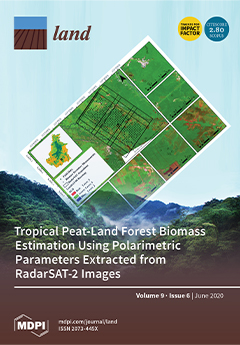This paper was aimed at estimating the forest aboveground biomass (AGB) in the Central Kalimantan tropical peatland forest, Indonesia, using polarimetric parameters extracted from RadarSAT-2 images. Six consecutive acquisitions of RadarSAT-2 full polarimetric data were acquired and polarimetric parameters were extracted. The backscattering
[...] Read more.
This paper was aimed at estimating the forest aboveground biomass (AGB) in the Central Kalimantan tropical peatland forest, Indonesia, using polarimetric parameters extracted from RadarSAT-2 images. Six consecutive acquisitions of RadarSAT-2 full polarimetric data were acquired and polarimetric parameters were extracted. The backscattering coefficient (
) for HH, HV, VH, and VV channels was computed respectively. Entropy (H) and alpha (
) were computed using eign decomposition. In order to understand the scattering behavior, Yamaguchi decomposition was performed to estimate surface scattering (
) and volume scattering (
) components. Similarly following polarimetric indices were computed; Biomass Index (BMI), Canopy Structure Index (CSI), Volume Scattering Index (VSI), Radar Vegetation Index (RVI) and Pedestal Height (
). The PolSAR parameters were evaluated in terms of their temporal consistency, inter-dependence, and suitability for forest aboveground biomass estimation across rainy and dry conditions. Regression analysis was performed between referenced biomass measurements and polarimetric parameters; VSI, H, RVI,
, and
were found significantly correlated with AGB. Biomass estimation was carried out using significant models. Resultant models were validated using field-based AGB measurements. Validation results show a significant correlation between measured and referenced biomass measurements with temporal consistency over the acquisition time period.
Full article





